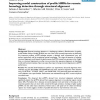Free Online Productivity Tools
i2Speak
i2Symbol
i2OCR
iTex2Img
iWeb2Print
iWeb2Shot
i2Type
iPdf2Split
iPdf2Merge
i2Bopomofo
i2Arabic
i2Style
i2Image
i2PDF
iLatex2Rtf
Sci2ools
BMCBI
2007
2007
Improving model construction of profile HMMs for remote homology detection through structural alignment
Background: Remote homology detection is a challenging problem in Bioinformatics. Arguably, profile Hidden Markov Models (pHMMs) are one of the most successful approaches in addressing this important problem. pHMM packages present a relatively small computational cost, and perform particularly well at recognizing remote homologies. This raises the question of whether structural alignments could impact the performance of pHMMs trained from proteins in the Twilight Zone, as structural alignments are often more accurate than sequence alignments at identifying motifs and functional residues. Next, we assess the impact of using structural alignments in pHMM performance. Results: We used the SCOP database to perform our experiments. Structural alignments were obtained using the 3DCOFFEE and MAMMOTH-mult tools; sequence alignments were obtained using CLUSTALW, TCOFFEE, MAFFT and PROBCONS. We performed leave-one-family-out cross-validation over super-families. Performance was evaluated throug...
| Added | 09 Dec 2010 |
| Updated | 09 Dec 2010 |
| Type | Journal |
| Year | 2007 |
| Where | BMCBI |
| Authors | Juliana S. Bernardes, Alberto M. R. Dávila, Vítor Santos Costa, Gerson Zaverucha |
Comments (0)

